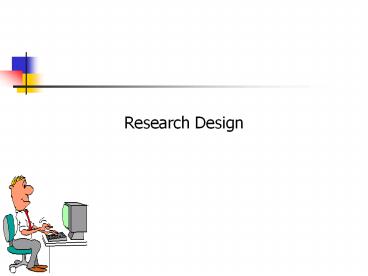Research Design - PowerPoint PPT Presentation
1 / 13
Title:
Research Design
Description:
Research Design Research Design: Definition A research design is a framework or blueprint for conducting the marketing research project. It details the procedures ... – PowerPoint PPT presentation
Number of Views:384
Avg rating:3.0/5.0
Title: Research Design
1
- Research Design
2
Research Design Definition
- A research design is a framework or blueprint for
conducting the marketing research project. It
details the procedures necessary for obtaining
the information needed to structure or solve
marketing research problems.
3
A Classification of Marketing Research Designs
Research Design
Conclusive Research Design
Exploratory Research Design
Descriptive Research
Causal Research
Cross-Sectional Design
Longitudinal Design
Single Cross-Sectional Design
Multiple Cross-Sectional Design
4
Exploratory Conclusive Research Differences
Exploratory
Conclusive
Objective Character-istics Findings
/Results Outcome
To provide insights and understanding. Informatio
n needed is defined only loosely. Research
process is flexible and unstructured. Sample is
small and non-representative. Analysis of
primary data is qualitative. Tentative. Genera
lly followed by further exploratory or conclusive
research.
To test specific hypotheses and examine
relationships. Information needed is clearly
defined. Research process is formal and
structured. Sample is large and representative.
Data analysis is quantitative. Conclusive. Fi
ndings used as input into decision making.
5
A Comparison of Basic Research Designs
Exploratory
Descriptive
Causal
Discovery of ideas and insights Flexible,
versatile Often the front end of total
research design Expert surveys Pilot
surveys Secondary data Qualitative research
Describe market characteristics or
functions Marked by the prior formulation of
specific hypotheses Preplanned and structured
design Secondary data Surveys Panels Observation
and other data
Determine cause and effect relationships Manipula
tion of one or more independent
variables Control of other mediating
variables Experiments
Objective Characteristics Methods
6
Uses of Exploratory Research
- Formulate a problem or define a problem more
precisely - Identify alternative courses of action
- Develop hypotheses
- Isolate key variables and relationships for
further examination - Gain insights for developing an approach to the
problem - Establish priorities for further research
7
Use of Descriptive Research
- To describe the characteristics of relevant
groups, such as consumers, salespeople,
organizations, or market areas. - To estimate the percentage of units in a
specified population exhibiting a certain
behavior. - To determine the perceptions of product
characteristics. - To determine the degree to which marketing
variables are associated. - To make specific predictions
8
Cross-sectional Designs
- Involve the collection of information from any
given sample of population elements only once. - In single cross-sectional designs, there is only
one sample of respondents and information is
obtained from this sample only once. - In multiple cross-sectional designs, there are
two or more samples of respondents, and
information from each sample is obtained only
once. Often, information from different samples
is obtained at different times.
9
Longitudinal Designs
- A fixed sample (or samples) of population
elements is measured repeatedly on the same
variables - A longitudinal design differs from a
cross-sectional design in that the sample or
samples remain the same over time
10
Uses of Casual Research
- To understand which variables are the cause
(independent variables) and which variables are
the effect (dependent variables) of a phenomenon - To determine the nature of the relationship
between the causal variables and the effect to be
predicted - METHOD Experiments
11
Potential Sources of Error inResearch Designs
12
Errors in Research
- The total error is the variation between the true
mean value in the population of the variable of
interest and the observed mean value obtained in
the research project. - Random sampling error is the variation between
the true mean value for the population and the
true mean value for the original sample. - Non-sampling errors can be attributed to sources
other than sampling, and they may be random or
nonrandom including errors in problem
definition, approach, scales, questionnaire
design, interviewing methods, and data
preparation and analysis. Non-sampling errors
consist of non-response errors and response
errors.
13
Errors in Research
- Non-response error arises when some of the
respondents included in the sample do not
respond. - Response error arises when respondents give
inaccurate answers or their answers are
misrecorded or misanalyzed.































